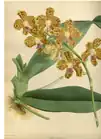| Phalaenopsis hygrochila | |
|---|---|
_23_(2015)_(49919747027).jpg.webp) | |
| Flowering Phalaenopsis hygrochila specimen in cultivation | |
_23_(2015)_(40761300893).jpg.webp) | |
| Flower detail | |
| Scientific classification | |
| Kingdom: | Plantae |
| Clade: | Tracheophytes |
| Clade: | Angiosperms |
| Clade: | Monocots |
| Order: | Asparagales |
| Family: | Orchidaceae |
| Subfamily: | Epidendroideae |
| Genus: | Phalaenopsis |
| Species: | P. hygrochila |
| Binomial name | |
| Phalaenopsis hygrochila J.M.H.Shaw[1] | |
| Synonyms[1] | |
| |
Phalaenopsis hygrochila, also known as 湿唇兰 (shi chun lan) in Chinese,[2] is a species of epiphytic orchid native to Assam, China South-Central, China Southeast, East Himalaya, Laos, Myanmar, Thailand, and Vietnam.[1]
Taxonomy
This species has a complex taxonomic history and has been previously assigned to several genera.[1]
Description
The 5–10 cm, sometimes up to 20 cm long stems are 8–15 mm wide and enclosed within persistent leaf sheaths. They bear oblong to obovate-oblong, unequally bilobed, coriaceous leaves, between 17 and 29 cm in length and 3.5-5.5 cm in width. Yellow flowers of 4–5 cm in diameter with purple spotting and a white lip with lavender colouration on the midlobe are produced on 5-8 flowered, axillary and often pendent inflorescences. One plant may produce up to 6 inflorescences at a time. Flowering occurs throughout June and July. The diploid chromosome count is 2n = 38.[2] Each pollinium is completely divided into two unequal halves.[3] The seeds are 238.7 µm long and 81.2 µm wide.[4]
Gallery
_23_(2015)_(47727915051).jpg.webp) Lateral view of flower bud in the process of opening
Lateral view of flower bud in the process of opening_23_(2015)_(33850801048).jpg.webp) Flower viewed from behind
Flower viewed from behind_23_(2015)_(49919759742).jpg.webp) Lateral view of fully closed, spurred flower buds
Lateral view of fully closed, spurred flower buds_23_(2015)_(49919751992).jpg.webp) Flowers growing on a pendent inflorescence
Flowers growing on a pendent inflorescence Flowering specimen mounted on a branch with moss
Flowering specimen mounted on a branch with moss Botanical illustration of Phalaenopsis hygrochila as Vanda parishii
Botanical illustration of Phalaenopsis hygrochila as Vanda parishii
Ecology
The plants are found in open forests in elevations of 700–1300 m.[2]
Conservation
This species is protected unter the CITES appendix II regulations of international trade.[5]
Horticulture
It has been utilized as an ornamental plant and cut flowers have been traded commercially, both locally and internationally. Artificial propagation and genetic transformation protocols were established.[6]
References
- 1 2 3 4 "Phalaenopsis hygrochila J.M.H.Shaw | Plants of the World Online | Kew Science". powo.science.kew.org. Retrieved 18 February 2022.
- 1 2 3 Wu, Z.Y., Raven, P.H. & Hong, D.Y. 2009 Flora of China Vol. 25 Orchidaceae Science Press, Beijing, and Missouri Botanical Garden Press St. Louis, MO. 446
- ↑ Li, M. H., Zhang, G. Q., Liu, Z. J., & Lan, S. R. (2014). Revision of Hygrochilus (Orchidaceae: Epidendroideae: Aeridinae) and a molecular phylogenetic analysis. Phytotaxa, 159(4), 256-268.
- ↑ Tongbram, J., Rao, A. N., & Vij, S. P. (2012). Seed morphometric studies in some orchids from Manipur. J. Orch. Soc. Ind, 26(1-2), 25-2.
- ↑ "Phalaenopsis". CITES.
- ↑ Pimda, W., & Bunnag, S. (2010). Protocorm wounding enhanced Agrobacteriummediated transformation of Hygrochilus parishii (Veitch & Rchb. f.) Pfitz. Advances in Agriculture & Botanics, 2(3), 205-212.